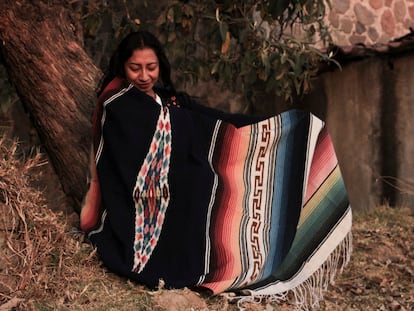Working with artisans or cultural exploitation? Aesthetic racism on the catwalk
A controversial fashion show in Colombia, in which two Emberá Chamí indigenous women were placed in the middle of a runway, has sparked an interesting debate in a country where artisan collections and fashion have been linked for decades

Two Emberá Chamí women, members of an indigenous group with over 77,000 people in Colombia, are seated in the middle of a catwalk at the local Eje Moda (Fashion Axis) fair. A video shown on the LED screens behind the catwalk suggests that they belong to a group of artisans who wove the materials used to make the pieces that will be showcased on the runway. One of the women is holding a baby. We don’t know their names. We do not know what they did. They stare into the distance as they remain seated. Meanwhile, models in bathing suits strut around the women without interacting with them. That invisibility—that silent, inert, almost decorative role in which they’ve been placed—soon goes viral on social media, raising serious questions. “Why are they there?” asks Colombian journalist Luz Lancheros. It’s “as [if they were a] decorative vase, like objects at an exhibit. [Like] any 19th-century imperialist country [treated] racialized people.”
The designer of the Madeira Exclusive swimwear brand later explained that the staging was meant as a tribute to them. But how was that a tribute? And do Colombia’s indigenous and artisan communities need another tribute, or do they urgently need to be seen as agents on equal footing with the designers they work with? “They said that they wanted to pay a tribute to [the Emberá women], but it’s a racist act. The conditions were set for these indigenous women to be exoticized and then go back to their reality, nothing more. They weren’t participating in anything, just being objectified by cultural appropriation, which has been repeated in Colombian fashion and global fashion over and over again,” adds the journalist.
Indeed, the naturalized, invisible mechanisms that led the designer—and her producers, the event’s directors, the videographers who shot the video and the community manager who uploaded the images on Instagram—to not be shocked by that scene reveals the reality of hidden systemic racism. It suggests that some see themselves as the saviors of others, and it reflects mechanisms that, despite the outrage they provoke, are not unusual in fashion. “Fashion has been the standard bearer of saving the Other who needs it, but it has done so through a gaze that reproduces power while thinking that it is transforming something. The problem is that it does not really question or change the structures that marginalize people based on race, for example; it merely dresses them in a new aesthetic. They’re not selling in the street, they’re not in a souvenir store: now they’re on the catwalk. It’s just an aesthetic displacement,” explains Edward Salazar, a PhD student in the Department of Latin American and Latino Studies at the University of California, Santa Cruz and the editor of a book on fashion in Colombia, Estudios de la moda en Colombia (Studies on Fashion in Colombia).
Una vez más vemos cómo una marca de vestidos de baño recurre a la romantización del pasado colonial. Esta vez ocurrió en un evento de la marca baobab, en la ciudad de Cartagena, donde contrataron a mujeres racializadas para hacer un performance esclavista. pic.twitter.com/hFxvyN6cbD
— Valeria Akl (@ValeriaAkl) February 26, 2023
But we are now living in a moment in which, beyond the paternalism and condescension with which others are viewed, it also seems imperative to ask ourselves, after decades of fashion’s work with artisanal and indigenous communities, where the indigenous and Afro-Colombian designers are. Where do they serve as representatives of their peoples, as opposed to just being represented? “If we are going to use all these elements that are part of our narrative of diversity, we should be thinking about something other than appropriation, so that these communities are not just suppliers but can move forward under equal conditions for creation,” says journalist Lancheros. Colombian designer Juan Pablo Socarrás, who has been recognized by the United Nations as a designer for development and has been working with different Colombian artisan communities for over 17 years, confesses that one of the most difficult things in fashion is moving toward sustainability and the inclusion of communities of any kind: artisans, indigenous people, populations in difficult circumstances. “It is a transition that demands the act of deep deconstruction and learning. That’s why when I see the images of this fashion show I think: we’ve all been there! We have all made those mistakes. In the beginning, when we started working with artisans, we all wanted to take them out, to show them in the fashion show, without understanding that it is not necessary or pleasant for them. The brands that want to embark on this path must be informed and get advice so that their work is respectful.”
The images of the Emberá women in this fashion show unleashed a torrent of criticism. They form part of a series of recent images that demonstrated that, as long as there is no collective and highly critical mobilization against the discourses of marginalization, class and racism, perhaps fashion, as a site of the symbolic production of meaning, is not prepared to embrace such narratives on a grand scale.
A few months ago, another local swimwear brand, Baobab, presented its collection in the historic city of Cartagena, which epitomizes the country’s colonial era. Baobab dressed the palenqueras [women from Palenque, Colombia, a historic town founded by runaway slaves] in white skirts and turbans; the women were left outside, without being able to attend the fashion show, and served for guests and models to pass by, as if the former were honoring the latter in the street. For many people, the display invoked “echoes of slavery.”
La moda colombiana lo vuelve a hacer de la manera más vergonzosa. Esta marca, en Eje Moda, pone a dos mujeres Embera con un bebe EN EL CENTRO DE LA PASARELA COMO FLORERO DECORATIVO, COMO OBJETOS DE EXHIBICIÓN. Cual país colonizador con las personas racializadas en el siglo XIX. pic.twitter.com/cRoDELqXDr
— Lux Lancheros 🦜 (@LuxAndLan) May 19, 2023
“That’s why the word deconstruction has become so relevant. What has to be deconstructed? Our colonial imaginary and minds. We have to review all the layers. If one does not remove oneself from the layers that seem natural, one will never stop seeing the other as a stranger,” explains Salazar. The scholar insists that before demanding changes in fashion, individuals must seek to change themselves: “Working at the personal level is the first thing [to do]. People must challenge the structures around them, the social class to which one belongs, the color of one’s skin and question the uniqueness of one’s narrative, one’s certainties, and understand where those certainties come from, understand that they come from the colonial power relations that we have inherited.
After nearly two decades of working with artisans, refining relationships and sharpening protocols, Juan Pablo Socarrás speaks specifically about working with very clear criteria for consent, compensation and recognition. For example, the labels of “co-created” garments state the names of the people who made the piece, the time they spent doing it and the generation and region they come from. “After all these years of work, it is very clear to me that they do not want us to rescue them, nor are they asking us to save them…They have a clear way of life based on their [own] cosmogony. Of course, some of them want to be in fashion shows in Paris, but the idea is to share skills and knowledge, so that artisan communities can become autonomous and sustainable over time and decide what they want to do [themselves].”
Beyond the lessons that these blunders have taught local brands, the fashion shows have prompted a national conversation in which the world of taste and images—which had always been condemned to being the most innocuous entertainment—is now at least starting to be considered politically relevant. “When you look at people’s comments and see how they react to the Emberá women or to more recent debates, like the one sparked by the Dior fashion show in Mexico, there are many who think: there is something profoundly wrong here. There are other people who say: yes, it is wrong, but they are being helped; they wanted to be there. Others say: I don’t see the problem, not everyone has to be the boss; the important thing is that they participate and get paid. This tension ultimately shifts the fashion paradigm; there is no longer just one voice. We no longer talk about whether fashion is frivolous or not … we talk about whether fashion is colonial or not, whether it is handmade or not, whether it can be feminist, global or national. It is leading to a very important debate about images and taste that wasn’t happening on a massive scale before,” Edward Salazar says.
Sign up for our weekly newsletter to get more English-language news coverage from EL PAÍS USA Edition
Tu suscripción se está usando en otro dispositivo
¿Quieres añadir otro usuario a tu suscripción?
Si continúas leyendo en este dispositivo, no se podrá leer en el otro.
FlechaTu suscripción se está usando en otro dispositivo y solo puedes acceder a EL PAÍS desde un dispositivo a la vez.
Si quieres compartir tu cuenta, cambia tu suscripción a la modalidad Premium, así podrás añadir otro usuario. Cada uno accederá con su propia cuenta de email, lo que os permitirá personalizar vuestra experiencia en EL PAÍS.
¿Tienes una suscripción de empresa? Accede aquí para contratar más cuentas.
En el caso de no saber quién está usando tu cuenta, te recomendamos cambiar tu contraseña aquí.
Si decides continuar compartiendo tu cuenta, este mensaje se mostrará en tu dispositivo y en el de la otra persona que está usando tu cuenta de forma indefinida, afectando a tu experiencia de lectura. Puedes consultar aquí los términos y condiciones de la suscripción digital.
More information
Archived In
Últimas noticias
Most viewed
- Reinhard Genzel, Nobel laureate in physics: ‘One-minute videos will never give you the truth’
- Oona Chaplin: ‘I told James Cameron that I was living in a treehouse and starting a permaculture project with a friend’
- Pablo Escobar’s hippos: A serious environmental problem, 40 years on
- Charles Dubouloz, mountaineering star, retires at 36 with a farewell tour inspired by Walter Bonatti
- Why we lost the habit of sleeping in two segments and how that changed our sense of time










































